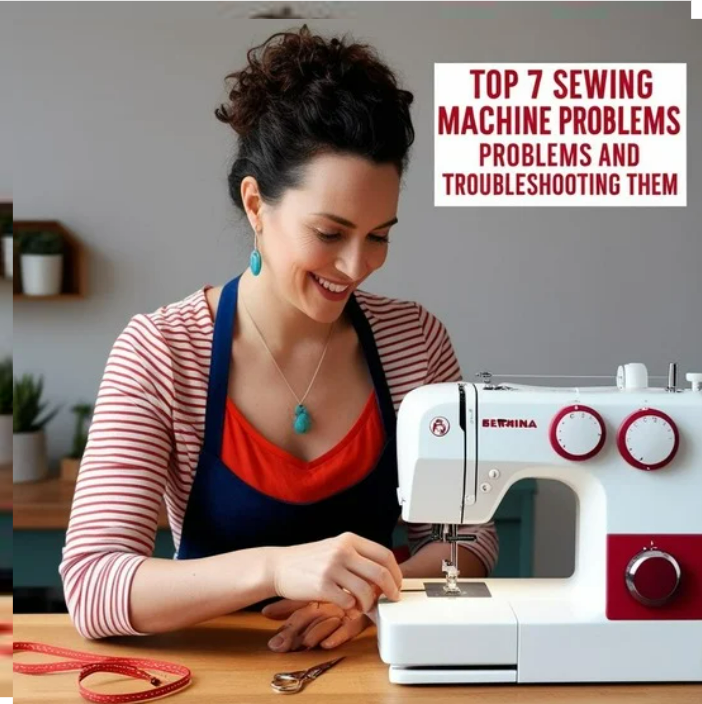
TOP 7 SEWING MACHINE PROBLEMS AND TROUBLESHOOTING THEM
Our goal at Topstitch is to help you clear all the roadblocks you face in the process of sewing from buying the correct sewing machine or serger to troubleshooting any issues you face when you start.
So if you find yourself fixing your sewing machine more than actually sewing with it, you might wanna give this article a read, as here we are reviewing the common problems our customers face and we try to fix these issues together by simple tips and tricks.
So here are the most common issues you may face while sewing, what are the causes behind it and quick fixes that will 100% make your life easier.
Let's dive in ...
Why is my machine not stitching evenly?
Missed or irregular stitches are often caused by -
- a dull, bent, or incorrect-size of the needle
- improper thread tension
- bobbin issues
- dust buildup
- using poor-quality threads.
To fix this, replace the needle with one suited for your fabric, adjust the thread tension for proper balance, and ensure the bobbin is wound evenly and inserted correctly. Regularly clean your machine to remove lint and debris, and avoid pulling or pushing the fabric too forcefully while sewing to maintain smooth, consistent stitches.
If the stitches are bunching up when you begin to sew you’re probably sewing too soon without lowering the dog not letting the fabric feed evenly so feed the fabric slowly, hold the threads in the beginning and lower the feed dog before starting.
Why does the thread Loops on Fabric Back?
This little situation here is called bird nesting, which may be caused by -
- Thread Tension Too Loose - if you’re using the wrong bobbin which is not compatible with your machine or the bobbin tension is too low the thread will pile up under the needle plate so using your tension screw just tighten it. Also, ensure that the top thread is threaded properly and the tension is perfect and you’re getting perfect stitches by checking the thread around the bobbin, spool holder and the take up lever.
- Improper size of the needle or damaged needles can also cause bird nests
- Before you begin, pull the bobbin thread to the top and leave at least a 6-inch (15 cm) tail on both the upper and bobbin thread. Hold the threads as you start sewing to keep them from being pulled into the machine. Also, avoid sewing too close to the fabric edge, as this can cause knots and jams.
- While backstitching or sewing thin fabrics might get pulled into the needle plates causing this issue.
- Low-presser foot pressure, turning the balance wheel clockwise instead of counter clockwise direction or clogged tension disk also causes bird nesting so adjust pressure accordingly and clean the tension disk.
Why does the Bobbin keep bunching up?
Here’s why your bobbin might be bunching up again and again
- Incorrect Bobbin Insertion causing tension issues so just reinsert it properly.
- Using cheap thread can cause fraying or breakage so use threads as per your fabric and its weight
- Unclog your machine and clean any lint, debris or dust in the feed dogs and bobbin area with a brush.
- Ensure your bobbins are compatible with your machines as it is one of the main causes of threading problems, so check you machine manual to find out the compatible bobbins.
- While threading you might not have placed the upper thread in the tension disc and lever correctly causing uneven feeding of thread, you’ll have rethread the machine to fix this issue.
Why does my machine keep jamming and how to fix it?
The main causes for jammingin a sewing machine are
- Tangled threads in the bobbin
- Clogged machine due to debris
- Too tight or too loose tension
- Broken needle
So to solve it open and rethread the bobbin, clean the machine and remove any clog and to prevent further clogging make sure you oil your machine, replace the needle if broken.
Why does the fabric keep puckering ?
While sewing lightweight or slippery material you may see that the fabric gets puckered up due to following reasons -
- Thread tension is too tight, if you can see your bobbin thread or there are loops in the lower thread to fix this readjust you machine’s thread tension as it makes the thread crumple.
- The pressure is not adjusted as per the fabric youre using especially if youre sewing fabrics of different weight.
- Improper bobbin threading, using poor quality needle and threads or using the wrong bobbin.
So choose the right needle, thread and bobbin before sewing.
Why won't the thread stay inside of the fabric while sewing?
The main reason behind this problem is improper thread tension so if you notice loops on the underside of the fabric, slightly tighten the top thread tension. If the top thread is pulling too much, loosen the tension for a balanced stitch. Check the threading path once more and make sure the thread is guided perfectly.
Other reasons can be an improper needle, unevenly wounded bobbins or build up near the tension disc.
What is the ideal tension or how to choose the ideal tension for your sewing needs?
Sewing tension involves the balance between the top and bottom threads that pass through a sewing machine to create stitches. An imbalance can lead to poor-quality stitches, with the thread being pulled to one side of the fabric.
Key points to consider are :
- Tension Settings: Tension needs to be adjusted based on the fabric being used. Generally, a setting of four is suitable for most fabrics.
- Signs of Incorrect Tension:
- If the top thread is visible underneath, it indicates the top thread is too loose.
- Conversely, if the bottom thread is visible on top, the top tension is too tight.
- Fabric Type Recommendations:
- Heavier fabrics may require higher tension settings.
- Lightweight fabrics should have reduced tension.
- Testing: It's advisable to start with a tension setting of four and adjust according to test stitch samples.
I hope you found these tips helpful. in case you still need help with these problems visit Topstitch store and talk to our experts directly, we're happy to help you anytime.
